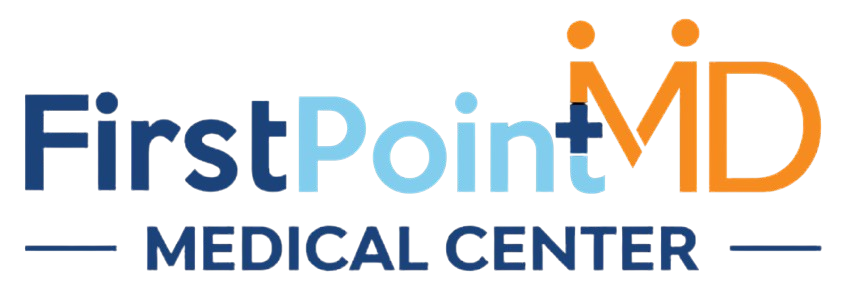At First Point MD, we understand how debilitating migraines can be. Beyond being “just a bad headache,” migraines are a complex neurological disorder, often triggered by an intricate interplay of internal and external stimuli. In this article, we explore in depth the pathophysiology of migraines, the neurological triggers that precipitate attacks, how they manifest across phases, and evidence-based strategies for prevention and management. Our aim is to provide a richly detailed reference for patients, clinicians, and anyone seeking deep insight into these enigmatic yet common headaches.
What Is a Migraine? A Neurological Disorder, Not Just Pain
A migraine is a recurrent, neurologically mediated headache disorder, often presenting as moderate to severe throbbing pain, usually unilateral, accompanied by nausea, light sensitivity (photophobia), sound sensitivity (phonophobia), and sometimes aura phenomena.
Migraines affect a significant portion of the population globally and contribute heavily to lost productivity and disability.They are generally considered a neurovascular disorder, involving interactions among the brain, blood vessels, and sensory nerves.
Migraine Phases
Migraine attacks classically progress through several phases (though not all phases occur in every patient)
-
Prodrome (Premonitory phase): Subtle signs may appear 12–48 hours before headache onset. These include mood changes, yawning, food cravings, neck stiffness, increased urination, and fatigue.
-
Aura: Reversible neurological symptoms, often visual (e.g., scintillating scotoma, zigzag lines, blind spots), sensory (numbness, tingling), or speech disturbances. Usually, aura lasts less than an hour.
-
Headache (Attack) Phase: The hallmark pain phase typically lasts 4 to 72 hours (if untreated). The pain is often pulsatile or throbbing, worsened by physical activity, and may be associated with nausea, vomiting, and sensitivities to light, sound, or smells.
-
Postdrome (Hangover phase): After the pain subsides, patients may experience fatigue, irritability, difficulty concentrating, and residual sensitivity to stimuli.
Understanding these phases helps in early recognition, early intervention, and appropriate preventive strategies.
The Neurobiology of Migraine: What Happens in the Brain
Migraines are not simply vascular spasms or dilations. They arise from neural excitability, cortical spreading phenomena, trigeminovascular activation, and neurogenic inflammation.
Cortical Spreading Depression (CSD) and Aura
In patients who experience aura, a wave of hyperexcitation followed by suppression of neuronal activity—called cortical spreading depression—propagates across the cortex. This phenomenon is strongly linked to aura symptoms and may activate trigeminovascular pain pathways.
CSD also triggers release of vasoactive and inflammatory mediators that sensitize trigeminal nerve endings.
Trigeminovascular System and Neurogenic Inflammation
The trigeminovascular system is central to migraine pain. Sensory fibers of the trigeminal nerve innervate the meninges and blood vessels. During migraine, these fibers release neuropeptides such as calcitonin gene–related peptide (CGRP), substance P, and neurokinin A. These molecules promote vasodilation, plasma extravasation, and mast cell activation, essentially producing a local inflammatory response (neurogenic inflammation).
CGRP in particular has become a major therapeutic target; drugs that block CGRP or its receptor are effective in migraine prevention.
Central Sensitization and Brain-stem Modulation
Over time, repeated migraine attacks can lead to central sensitization—where neurons in the brainstem and cortex become hyperresponsive to stimuli. This amplifies pain signals and lowers the threshold for future attacks.
Regions in the brainstem, hypothalamus, and thalamus are implicated in modulating migraine activity, especially during the prodromal phase. Imaging studies show activation of the hypothalamus and brainstem nuclei even before headache onset.
Neuroplasticity, Genetic Predisposition, and Ion Homeostasis
Migraine susceptibility is strongly influenced by genetic variants in ion channels, neurotransmitter systems, and vascular regulation.
Repeated attacks can drive neuroplastic changes—long-term alterations in excitability, connectivity, and threshold of neuronal circuits.
Disruption of ionic homeostasis—especially sodium, potassium, and calcium flux—plays a role in the initiation and propagation of CSD and neuronal hyperexcitability.
Neurological Triggers That Precipitate Migraines
Migraine triggers are often described by patients as factors that “set off” an attack. However, scientific evidence suggests triggers may act in combination, and some presumed triggers may actually be premonitory symptoms (i.e., early parts of an attack).
Nonetheless, awareness of potential triggers helps manage susceptibility. Below are key neurological and environmental triggers with strong clinical and research support:
Emotional Stress and “Let-down” Periods
Stress is perhaps the most commonly reported trigger. Up to 70 % of migraineurs cite emotional stress or tension as a precursor to attacks. Interestingly, periods immediately following stress—relaxation, vacation, or “weekend let-downs”—are also high-risk windows.
Sleep Disturbance: Too Little or Too Much
Irregularities in sleep—either sleep deprivation or oversleeping—are recognized triggers. Poor sleep quality contributes to sensitization of neurological pain pathways.
Hormonal Fluctuations (Especially in Women)
Migraine prevalence is higher among women, largely due to fluctuations in estrogen. Many women experience menstrual migraine, with attacks often clustering around menses or ovulation. Hormonal contraceptives or hormone stabilization may help in some cases.
Dietary & Metabolic Triggers
-
Skipping meals or fasting can destabilize glucose levels and trigger migraines.
-
Caffeine: Both overuse and sudden withdrawal may precipitate attacks.
-
Alcohol, especially red wine, is a frequently reported trigger.
-
Food additives and compounds such as MSG, nitrates, tyramine, and artificial sweeteners are implicated—though evidence is variable and often individual-specific.
Sensory Stimuli: Light, Sound, Smell
-
Bright, flickering, or pattern-based lighting can trigger or worsen migraine pain.
-
Loud noises or sudden sounds similarly provoke attacks.
-
Strong odors, perfumes, chemical fumes and irritants may precipitate migraine pain.
Weather and Barometric Pressure Changes
Shifts in atmospheric pressure, humidity, temperature, or storms are common environmental triggers reported by many migraine sufferers.
Neck or Cervical Irritation / Postural Strain
Muscle tension, posture changes, or cervical spine issues can sensitize nearby nerves and contribute to initiation of an attack.
Medication Overuse & Rebound Headache
Frequent overuse of analgesics (especially combination painkillers or triptans) may lead to medication overuse headache, making migraines worse or more frequent.
Combined or “Threshold” Effects
In many cases, no single trigger is sufficient; instead, multiple triggers converge to exceed a neuronal threshold of excitability, precipitating an attack.
Clinical Approach: Diagnosing and Evaluating Migraines
A careful neurological evaluation is essential to distinguish migraines from other headache disorders and to guide treatment:
History & Symptom Patterns
-
Detailed headache history (onset, location, character, duration, associated symptoms)
-
Aura features (timing, type, duration)
-
Precipitating or prodromal symptoms
-
Family history of migraine or other headaches
-
Medication and trigger history (including over-the-counter and lifestyle)
-
Assessment of headache frequency (days per month) to assess for chronic transformation risk
Neurological Examination & Red Flags
-
Neurologic exam to exclude secondary causes
-
Look for red flags: sudden “thunderclap” onset, focal neurologic signs, systemic symptoms, age of onset > 50 years, changes in pattern
Neuroimaging and Ancillary Testing
Routine imaging is not needed in typical migraine. However, MRI or CT may be warranted with atypical features or red flags.
Emerging modalities (e.g., functional imaging) are used in research to explore migraine networks and biomarkers.
Headache Diaries / Trigger Logs
Keeping a detailed diary to track headache onset, duration, intensity, associated symptoms, and potential triggers is invaluable. This aids in identifying patterns and guiding lifestyle adjustments.
From Episodic to Chronic: Risk Factors and Transformation
Some patients progress from episodic migraine (<15 headache days/month) to chronic migraine (≥15 days/month for >3 months). Risk enhancers include:
-
High baseline headache frequency
-
Obesity
-
Depression, anxiety, sleep disorders
-
Overuse of analgesics
-
Caffeine overuse
-
Uncontrolled stress or comorbidities
Preventing chronification is a key goal of early, aggressive management.
Strategies for Prevention, Management, and Relief
Because migraines are multifaceted, effective management is multimodal. At First Point MD, we emphasize integrating lifestyle, pharmacologic, and procedural approaches tailored to the patient.
Trigger Management & Lifestyle Stabilization
-
Maintain regular sleep schedule (consistent wake/sleep times)
-
Eat regularly, avoid skipping meals
-
Hydration, avoiding excessive caffeine or abrupt cessation
-
Regular physical activity (aerobic exercise)
-
Stress reduction: mindfulness, cognitive behavioral therapy, biofeedback
-
Avoid identified triggers when possible (lights, odors, strong noises, abrupt weather changes)
-
Posture, ergonomics, neck care
Lifestyle adjustments alone may not stop all attacks, but they raise the threshold and reduce frequency.
Acute (Abortive) Therapies
At the onset of migraine symptoms:
-
NSAIDs, acetaminophen, or combination analgesics
-
Triptans (serotonin 5-HT1B/1D agonists)
-
Ditans (e.g. lasmiditan) or gepants (CGRP receptor antagonists) (newer options)
-
Anti-emetics (metoclopramide, prochlorperazine) for nausea/vomiting
-
Neuromodulation devices: noninvasive stimulators targeting vagus nerve or trigeminal pathways (as adjunct / alternative)
Prompt treatment, ideally within first hours, improves outcomes and prevents central sensitization.
Preventive (Prophylactic) Therapies
For patients with frequent, disabling, or medically refractory migraine, we consider preventive medications:
-
CGRP monoclonal antibodies or small molecule CGRP antagonists
-
Beta-blockers (e.g. propranolol)
-
Antiepileptics (e.g. topiramate, valproate)
-
Antidepressants (e.g. amitriptyline, venlafaxine)
-
Botulinum toxin (Botox) for chronic migraine
-
Lifestyle-centric interventions remain foundational
Choice of agent is individualized based on comorbidities, side effect tolerability, and interaction profiles.
Interventional and Neuromodulation Therapies
In cases resistant to standard therapy:
-
Occipital nerve blocks or peripheral nerve blocks
-
Transcranial magnetic stimulation (TMS) in some cases
-
Implantable neuromodulation or occipital nerve stimulators (in refractory, select patients)
-
Behavioral and cognitive therapies
Emerging neuromodulation targets promise focused modulation of pain networks with fewer systemic side effects.
Monitoring, Tapering, and Adjustment
-
Periodic follow-up and assessment of response
-
Adjustment of dosage or switching medications
-
Gradual tapering of preventive agents when remission achieved
-
Vigilant monitoring of medication side effects and adherence
When to Seek Specialist or Advanced Care
Referral to a neurologist or headache specialist is warranted in:
-
Frequent (≥4–5/month) or chronic migraines
-
Poor response to first-line therapies
-
Suspected secondary headache or red flags
-
Use of advanced neuromodulation therapies
-
Considering novel CGRP therapies or complex treatment regimens
Collaboration between generalists, neurologists, and pain specialists ensures tailored, evolving care.
Conclusion
Migraines are fundamentally neurological—but manifest through vascular, inflammatory, and sensory pathways triggered by internal and external stimuli. Understanding the neurobiology, triggers, clinical progression, and strategic individualized management is essential for reducing the burden of migraine attacks.
At First Point MD, we prioritize a patient-centric, evidence-based approach:
-
Comprehensive diagnostic evaluation
-
Personalized trigger identification
-
Lifestyle optimization
-
Acute therapy protocols
-
Preventive regimens
-
Advanced interventions when needed
Through early recognition, disciplined management, and ongoing support, we aim to help migraine sufferers reclaim quality of life and reduce the frequency and severity of attacks.


